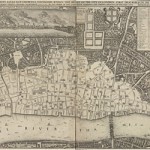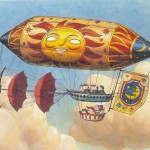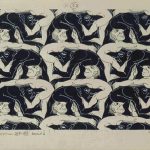A collaborative medium, a place where we all meet and read and write.
Tim Berners-Lee
[Part 2 of 7 : 0) intro, 1) story, 2) pictures, 3) users, 4) content, 5) structure, 6) social media, 7) evaluation]
The first picture ever uploaded onto the Internet was a photoshopped gif of a female comedy group at CERN called The Horrible Cernettes. Tim Berners-Lee uploaded the image to show that the Internet could be much more than physics laboratories sharing data worldwide.
The links above complain that it is a dreadful first image for making history, but I think that is in part because Berners-Lee wanted to make a point about what the Internet could be, so the content was the least of his worries. It wasn’t about the content. It was about the Internet being a place where we all meet. And, this is what is ultimately so liberating about our digital culture. We all get a say in what makes culture. And, perhaps physicists have different ideas about what is culturally important which, after all, is what makes The Big Bang Theory so brilliant and funny.
However, if we look at the ancient cave paintings found on the Island of Sulawesi, Indonesai, of hand prints and pig deer, we get a very different feeling. Archaeologists believe that they are at least 39,000 years ago and are among the oldest examples of figurative art, but cannot say for sure what they represent. They are beautiful and I look at them with awe, which is probably why some archaeologists speculate that they represent a belief system the artists held. Or perhaps, they are a world view, like the cave of swimmers, found in the Sahara. These paintings are only 8,000 years old, but have given rise to the theory that the Sahara was a place where people used to swim, before climate change turned it into a desert. We may never know.
I asked my girls what they thought the pictures of hands and beasts and swimmers meant. One said: This is me. Remember me. The other said: Spread my imagination. In other words, my girls think these images were drawn so that the artists could make their mark, record and share their worldview and be remembered, which I believe is why people create today whether it is images or words.
Science research website, Greater Good asked seven artists: Why do you make art? And they got the same response as the ones my junior school girls gave me with a couple of additions/variations:
Making art for fun and adventure; building bridges between themselves and the rest of humanity; reuniting and recording fragments of thought, feeling, and memory; and saying things that they can’t express in any other way.
When they asked Hip-hop artist, KRS-One, he said:
Put a writing utensil in any kid’s hand at age two or three. They will not write on a paper like they’ll later be socialized to do, they will write on the walls. They’re just playing. That’s human. Graffiti reminds you of your humanity, when you scrawl your self-expression on the wall.
Which is so true. The ancient images were drawn on the wall. They are self-expression and remind us of our humanity, which is why they are so moving. Interestingly, hurried scrawled graffiti has been found on ancient monuments, and on the walls in Pompeii. And, in Rome on a church wall, the first words of Italian graffiti, or Vulgar Latin, were written, written like a response, in the vernacular, representing the ordinary person’s thoughts. Today, graffiti is shorthand for unsolicited markings on a private or public property and is usually considered to be vandalism. Yet, some of it is breathtaking and elaborate. There are three categories of graffiti: Tourist graffiti (‘John wuz here’), inner-city graffiti (tagging and street art), and toilet graffiti (latrinalia) described in a fabulous Atlantic article. Graffiti is a way of people contributing to the conversation like when people leave their comments and links below.
As is painting, so is poetry
The Roman poet Horace ut pictura poesis (as is painting, so is poetry) made the link between word and image, which has kept the art world busy for centuries. Aristotle’s theory of drama considered the balance of lexis (speech) and opsis (spectacle) in tragedy. So we can see that ancient theories of memory use words and images, which no doubt inspired the more modern and controversial Dual Coding Theory, which says that when someone is learning a new word, if a meaningful picture is given alongside it, the learner will retain it more easily than if it didn’t have an accompanying picture. This is reminiscent of the ubiquitous meme: lovely quotation, lovely image, shared experience, which has a gestalt feel of something meaningful.
Hieroglyphics
The first written language was a language of images – the Hieroglyphics. However, the appreciation of their meaning was lost until the decoding of The Rosetta Stone which took so long because the code breakers they thought they were decoding images. It was only when they realised that the Hieroglyphics were a language and needed to be treated as such, did they decode the stone.
Like all languages, Hieroglyphics are an organised form of communication because you can’t build something as grand as the Pyramids without communicating clearly and communication is a way of advancing humanity. However, Hieroglyphics began as decorative symbols for priests – a gift of sacred signs given from the God Thoth – and were used to record the meaning of life and religion and magic. These were too elaborate for merchants, who adopted a simpler version to preserve their transactions, until Hieroglyphics fell out of favour for the more practical cursive Coptic script, which gave way to Arabic and Latin, languages we recognise today, in which communication was preserved and recorded to enrich future generations.
Images reward us
Research, particularly in the field of neuroesthetics, which is how the visual brain appreciates visual art, shows us that art is a rewarding experience. It is not necessarily the message itself which the viewer finds rewarding, it is how it is delivered. That is to say, it is it is not what is painted, it is how it is painted that lights up the brain’s reward centre. And, we prefer images to photographs, because the brain is free to interpret meaning even though it ultimately prefers to see a representation of what is in nature. And why wouldn’t it?
The asethetics of nature
In nature we find so many pleasing patterns. We also are attracted to art and people who are asethetically pleasing. The golden ratio is a pattern which appears in nature and has been used in art, as has symmetry. The most beautiful people have symmetrical faces and the most average facial features. We are naturally attracted to beautiful people in paintings and real life.
And, we are also influenced by them, which marketers have long recognised. They use lovely images to wrap their products in knowing that us consumers will be more willing to consume something which looks beautiful. This is known as the art infusion effect.
It is the same for newspapers, pictures sell more copy. The Illustrated London News was created in 1842 and had 60,000 subscribers in that year alone, after someone realised that newspapers sold more copies when they had pictures in them, especially ones which showed a face or place. But it wasn’t until 1889 that photographs were used in newspapers.
Images online
And so it is online, Jakob Nielsen says that users pay close attention to photos and other images that contain relevant information but will ignore pictures used to jazz up web pages. Stock pictures of people in business situations get ignored but pictures of people who write the blogs or work in the companies get studied 10% longer than their written biographies which often accompany any photograph. If you are selling a product you need high quality photographs which users can inspect and compare.
Users want to be educated by the images and find out things which is ultimately why they are on your website. Edward Tufte has written extensively about excellence in statistical graphics and visualising data. His says that users are sophisticated individuals so:
Give them the greatest number of ideas, in the shortest time, with the least ink, in the smallest space.
There is no need to dumb down. When a graphic is well created, patterns can be seen and understood on different levels.
In a great talk for An Event Apart, Designer and Developer Advocate at Mozilla, Jen Simmons looks offline at magazines for inspiration and remembers how there was much experimentation and creativity online until everyone adopted grids and fell into a rut. She also outlines ways of using responsive images, for leaner, faster pics, and highlights new cool and practical uses of imagery with the latest tags from W3C.
Images are communications which have the power to change us. Here are some:
- 29 of the most influential pictures of all time or 40 famous photos.
- The most influential works of art.
- Top 10 stereotypical student posters.
Content aside, the urls are precisely named to drive traffic via social media.
However, if all else fails, talk to your user and learn all about what they are looking for, before you share your beautiful art.
[Part 3:Web design: Getting to grips with your user’s experience]







10 comments